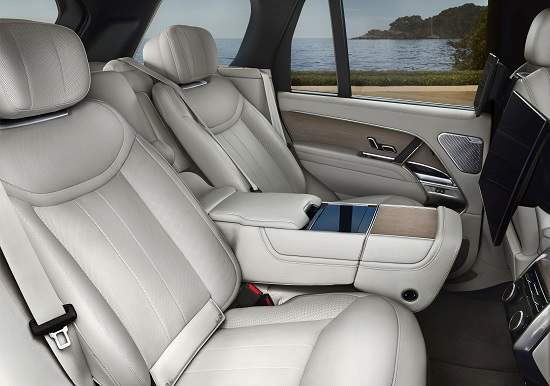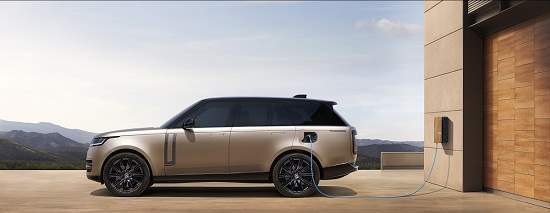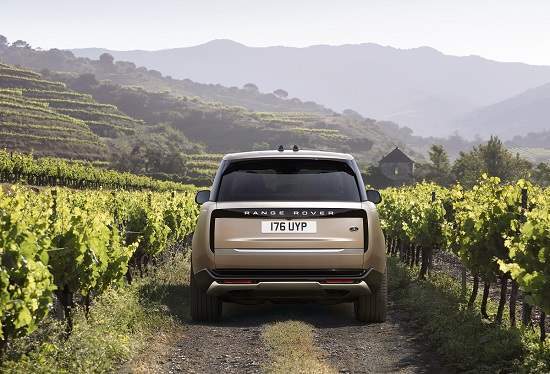Land Rover has launched the new Range Rover — an epitome of modernity and refinement and the fruit of 50 years of
development. According to Land Rover’s design director, Massimo Frascella, the
new design is all about reductionism, blurring the lines and joints in the body
to give a modest take on modern luxury.
اضافة اعلان
The SUV is distinguished by three main lines: the
sloping roof line, the prominent front center line, and the rising sill line.
These recognizable features blend with short front overhangs and a new
boat-tail tailgate with two-door horizontally opening for a sleek profile.
 (Photos: Handouts from Range Rover)
(Photos: Handouts from Range Rover)
At the front, the grille has been refreshed with a new-look
pattern, the standard digital LED headlights are sharper, and most of the car’s
sensors for its driver assistance systems have been incorporated into a panel
in the bumper to give a smoother and cleaner look. This also helps to reduce
drag and improve aerodynamics. Land Rover’s design reductionism is clear at the
rear, where the biggest styling changes for the new car can be seen. The taillights
and indicators have been incorporated into a solid-looking black panel that appears
opaque when the lights are off.
Available models and design
The SUV is available in the SE, HSE, and Autobiography
models. The first edition will be available throughout the first year of
production and is based on the Autobiography model.
The cabin, which is available in several styles, is
characterized by carefully selected materials, such as alternatives to
traditional leather. Additionally, the long wheelbase (LWB) model adds an extra
200mm between the car’s axles. We tried the third row at the car’s unveiling
and, while there is not as much room as in the brand’s larger Discovery,
there’s still enough space for children and adults to sit for shorter journeys.
Improved torsional rigidity (up to 50 percent) from the new aluminum-intensive
platform means Land Rover’s engineers have been able to increase the door aperture
size to improve access.
Short wheelbase (SWB) models can be purchased with five
seats, and the Executive Class Seating pack comes with four seats. The
individual chairs in the rear are available on SWB and LWB cars, improving
kneeroom by 44mm.
This package also adds an eight-inch touchscreen controller
in the back to tune the rear cabin environment. If you want the seven-seat
layout, you’re restricted to the LWB form. The new Range Rover adopts Land
Rover’s latest Pivi Pro infotainment system with a gently curved 13.1-inch
touchscreen on the dash. The brand stated that 90 percent of tasks can be
accessed on the home screen.
 (Photos: Handouts from Range Rover)
(Photos: Handouts from Range Rover)
There’s a 13.7-inch digital dash panel, and buyers can opt
for a Rear Seat Entertainment package, which adds a pair of 11.4-inch HD
touchscreens mounted on the front seatbacks.
Fifteen-watt wireless phone charging is available on offer,
as well as up to 60w of power to charge devices via USB-C.
The cabin also comes with an “enhanced cabin air
purification” system that includes a 2.5 picometer air filtration system with
Nano X technology that helps reduce odors, bacteria, and allergens, including
the COVID-19 virus.
Shared electrification across both plug-in choices means
hybrid Range Rover variants can travel up to 95km on full charge, with Land
Rover claiming a real-world zero-emission range of 80.4km and CO2 emissions of
less than 30g/km.
New features
What's new in the new Range Rover is the standard all-wheel
steering, which combines superior stability at high speeds and exceptional
maneuverability at low speeds, with a turning circle of less than 11 cubic meters.
The new Range Rover features the MLA-Flex Standard
Longitudinal Body (MLA-Flex) chassis that delivers standard long-wheelbase body
shapes, with a luxurious four-, five-, or seven-seater cabin, and a range of
electric powertrains.
 (Photos: Handouts from Range Rover)
(Photos: Handouts from Range Rover)
Initially, the new Range Rover will be offered as a plug-in
hybrid with longer driving range: the 510 hp and 440 hp plug-in hybrid models
provide a silent driving range of 100km and CO2 emissions as low as 30 g/km for
comfortable driving and high efficiency. Rapid charging capability at up to
50kW is included, so an 80 percent top-up will take less than an hour. A full
charge takes five hours using a home wall box.
Alongside fully electric EV mode, there’s a choice of Hybrid
mode — the default setting, which combines both power sources and uses
predictive energy optimization tech.
The new Range Rover is available with a 530-horsepower
eight-cylinder engine and twin turbo, with the “Dynamic Takeoff” system
accelerating from 0 to 100 km/h in only 4.6 seconds.
 (Photos: Handouts from Range Rover)
(Photos: Handouts from Range Rover)
Continuing the electrification journey, the all-electric
Range Rover will be launched in 2024 as part of the “Reimagined” strategy,
making the original SUV available with an all-electric powertrain. All
powertrains are mated to an eight-speed automatic gearbox with low-range
capability and Land Rover’s four-wheel drive system with Terrain Response 2
tech that tailors the drivetrain to different surfaces.
FUN FACT
The Range Rover series has enjoyed undisputed supremacy over
all SUVs for 50 years
GOOD
Range Rover distinctive styling, premium quality, luxurious
interior, undisputed off-road and on-the-road top performance, surprising fuel
economy for the PHEV versions
BAD
The price
AUTHOR’S RATING
9.0/10
BODY TYPE
E-Segment premium SUV
ENGINE: P530
V8 4.4L Automatic
Stop/Start
TRANSMISMISSION
Transmission, 8-speed automatic, four-wheel drive
ENGINE POWER
Horse Power: 530 hp / Torque: 750NM
TOP SPEED
Km/h: 250
0 to 100km/h : 4.6 Seconds
Fuel Consumption
Combined 11.8L/100km
DIMENSIONS
Length 5,052mm
Width 2,209mm
Height 1,870mm
Wheelbase 2,997mm
Curb weight 2585kg
PRICE
Not yet Available
Read more Drive





